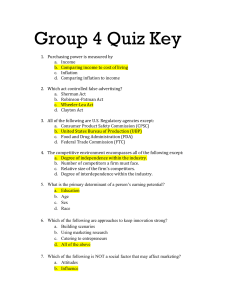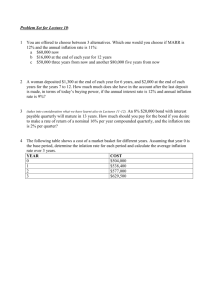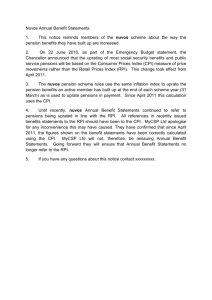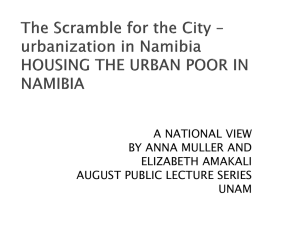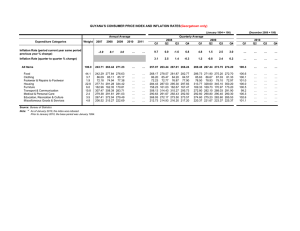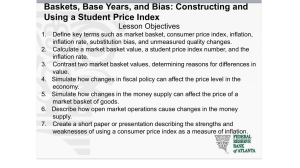6. The squeeze on incomes Summary •
advertisement
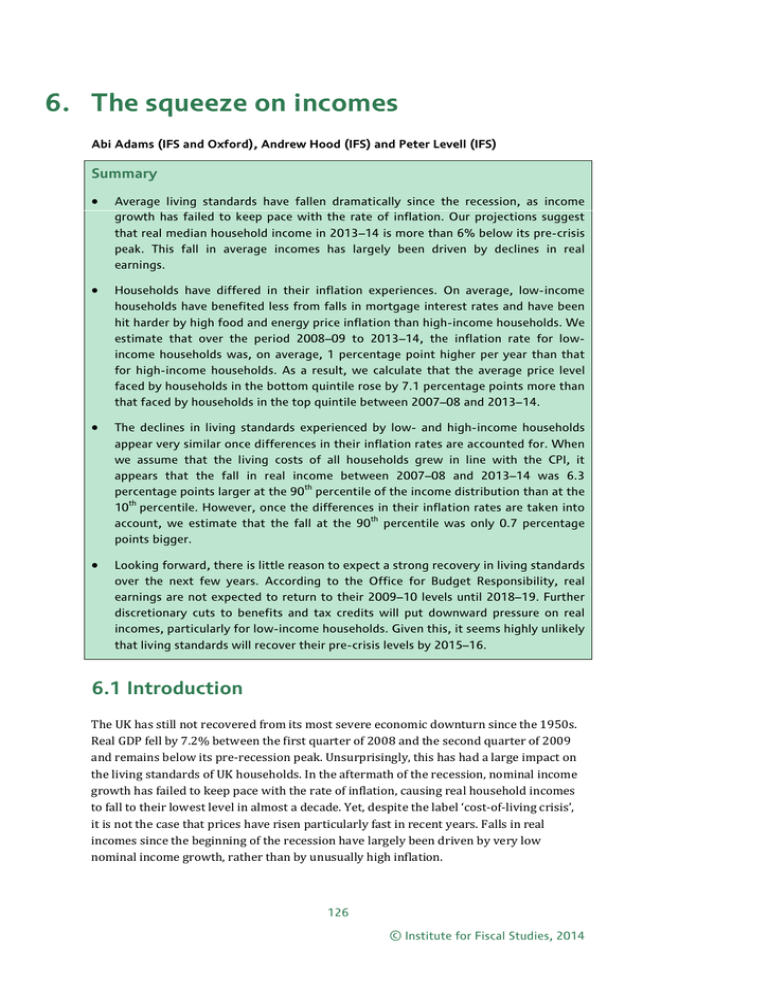
6. The squeeze on incomes Abi Adams (IFS and Oxford), Andrew Hood (IFS) and Peter Levell (IFS) Summary • Average living standards have fallen dramatically since the recession, as income growth has failed to keep pace with the rate of inflation. Our projections suggest that real median household income in 2013–14 is more than 6% below its pre-crisis peak. This fall in average incomes has largely been driven by declines in real earnings. • Households have differed in their inflation experiences. On average, low-income households have benefited less from falls in mortgage interest rates and have been hit harder by high food and energy price inflation than high-income households. We estimate that over the period 2008–09 to 2013–14, the inflation rate for lowincome households was, on average, 1 percentage point higher per year than that for high-income households. As a result, we calculate that the average price level faced by households in the bottom quintile rose by 7.1 percentage points more than that faced by households in the top quintile between 2007–08 and 2013–14. • The declines in living standards experienced by low- and high-income households appear very similar once differences in their inflation rates are accounted for. When we assume that the living costs of all households grew in line with the CPI, it appears that the fall in real income between 2007–08 and 2013–14 was 6.3 th percentage points larger at the 90 percentile of the income distribution than at the th 10 percentile. However, once the differences in their inflation rates are taken into th account, we estimate that the fall at the 90 percentile was only 0.7 percentage points bigger. • Looking forward, there is little reason to expect a strong recovery in living standards over the next few years. According to the Office for Budget Responsibility, real earnings are not expected to return to their 2009–10 levels until 2018–19. Further discretionary cuts to benefits and tax credits will put downward pressure on real incomes, particularly for low-income households. Given this, it seems highly unlikely that living standards will recover their pre-crisis levels by 2015–16. 6.1 Introduction The UK has still not recovered from its most severe economic downturn since the 1950s. Real GDP fell by 7.2% between the first quarter of 2008 and the second quarter of 2009 and remains below its pre-recession peak. Unsurprisingly, this has had a large impact on the living standards of UK households. In the aftermath of the recession, nominal income growth has failed to keep pace with the rate of inflation, causing real household incomes to fall to their lowest level in almost a decade. Yet, despite the label ‘cost-of-living crisis’, it is not the case that prices have risen particularly fast in recent years. Falls in real incomes since the beginning of the recession have largely been driven by very low nominal income growth, rather than by unusually high inflation. 126 © Institute for Fiscal Studies, 2014 The squeeze on incomes In this chapter, we describe the changes in incomes and prices that have resulted in falling living standards. Section 6.2 discusses the large falls in average real incomes that have occurred since the recession and why these falls have differed across the income distribution. Sections 6.3 and 6.4 explore how the inflation rate has varied between different groups in society, allowing a more accurate assessment of how living standards have changed for each group. Section 6.5 concludes. 6.2 Changes in incomes In what follows, we use official income data drawn from the Department for Work and Pensions (DWP)’s Households Below Average Income (HBAI) series up to 2011–12, and our own projections for household incomes since 2011–12, for our analysis. The HBAI series is based on data from the Family Resources Survey (FRS), an annual repeated cross-section of about 25,000 households, which collects detailed information on income levels and income sources. As the most recent HBAI series is for the financial year 2011–12, analyses based on this official source alone would be unable to present a picture of the changes in living standards that have occurred in the last two years. For this reason, we use microsimulation techniques to project the income distribution in 2012–13 and 2013–14, taking into account known or predicted changes to demographics, government policy and macroeconomic performance. We are thus able to look at income changes at the median (and other percentiles of the distribution) between 2011–12 and 2013–14. 1 Box 6.1 contains more details on the methodology underlying our projections. Box 6.1. Methodology underlying household income projections This box contains an overview of the steps taken to produce our income projections and a discusses some of the limitations of our methodology. • We begin with the latest available micro-data on household incomes in the UK: a sample of 20,697 households from the 2011–12 FRS. The data come with a set of weights to ensure that the weighted sample is representative of the UK as a whole in 2011–12. • We reweight the data to account for changes in the demographic characteristics of the population, and the number of people employed, between 2011–12 and 2013– 14. We use the Office for Budget Responsibility (OBR) figures (including a forecast for 2013–14) for average total employment in each financial year, and we allow employment trends to vary across the UK by region and industry according to forecasts produced by Oxford Economics. • Financial variables (most importantly, earnings) in the FRS data are increased in line with OBR projections (including a forecast for 2013–14). Earnings growth is allowed to vary across industries according to forecasts produced by Oxford Economics. • We calculate tax liabilities, and benefit and tax credit entitlements, using the IFS tax and benefit microsimulation model, TAXBEN. We then adjust for the fact that not all means-tested benefit and tax credit entitlements are taken up: if a household did 1 We do not present mean income projections because data limitations make it extremely difficult to project changes at the very top of the distribution. We also do not present separate projections for pensioner incomes, as future pensioners are likely to have higher pension entitlements (which we do not model) than current pensioners. 127 The IFS Green Budget: February 2014 not report receiving a particular benefit or tax credit in 2011–12, but the data suggest that they were entitled to it, we assume that the household will continue not to take up that entitlement. • From this, we create a measure of disposable income as close as possible to that used when calculating official income statistics. These projections are subject to a number of uncertainties and limitations: • There are uncertainties surrounding demographic and macroeconomic forecasts. • There is sampling error in the data. • Our methodology does not directly account for behavioural responses to tax and benefit policies, though they are accounted for indirectly to the extent that they are incorporated in the demographic and economic forecasts that are used in our model. That said, we believe that this methodology results in the best available estimate of incomes in 2012–13 and 2013–14. Using the same method, we projected a fall in a median income of 2.6% in 2011–12, compared with an actual fall of 2.8%. a A full description and discussion can be found in J. Browne, A. Hood and R. Joyce, Child and Working-Age Poverty in Northern Ireland from 2010 to 2020, IFS Report R78, 2013, http://www.ifs.org.uk/publications/6668. Throughout this section, we adjust incomes for inflation using the consumer price index (CPI) unless otherwise stated. This is different from the official HBAI income statistics, which use a variant of the retail price index (RPI) that excludes council tax expenditures. 2 Box 6.2 provides a discussion of the relative merits of these different inflation measures. Box 6.2. The choice of price index to deflate nominal income Going from statements about changes in incomes to statements about changes in living standards requires raw income figures to be adjusted, or ‘deflated’, to reflect changes in the cost of goods and services over time. However, there is no one measure of the cost of living to apply in this circumstance. We present income figures deflated by both the consumer price index and a variant of the retail price index that excludes council tax expenditures. The CPI is the level of inflation that is targeted by the Bank of England and is the default measure used by the government to uprate benefits, tax credits and public service pensions. However, the CPI does not cover owner-occupied housing costs. As will be discussed in Section 6.3, this causes difficulties in making statements about living standards when deflating incomes using the CPI, because of the large changes in mortgage interest costs that have occurred since the recession. The RPI (minus council tax expenditures) does include owner-occupied housing costs and is used to deflate nominal incomes in the official HBAI income series. However, the RPI lost its National Statistics status in March 2013 owing to concerns about the upward bias caused by the mathematical formula – the Carli index – that underlies its calculation. As a consequence, the RPI is thought to overstate somewhat the true rise in living costs experienced by households. 2 This variant of the RPI is used to adjust HBAI incomes measured before housing costs because the income measure used nets off council tax payments. 128 The squeeze on incomes Versions of the RPI that do not make use of the Carli index (the ‘RPIJ’) and of the CPI that include owner-occupied housing costs (the ‘CPIH’) exist. Ideally, we would use these indices for our analysis as they improve upon the RPI and the CPI respectively. However, the CPIH is not available before 2005 and neither index is forecasted by the OBR. Further, price indices are not published for the subcomponents of the RPIJ, which precludes its use in our analysis in Section 6.4. Given that we are interested in the changes in living standards that have occurred since the early 2000s, and in those that will occur in the future, we use the CPI as our default measure for deflating incomes and discuss the effect of housing costs on our conclusions in more depth in Section 6.3. In practice, the CPIH does not tend to differ greatly from the CPI (on average between 2006 and 2013, inflation measured by the CPIH was 0.2 percentage points lower than inflation measured by the CPI). Table 6.1 documents the change in mean and median real household income since 2001– 02, adjusting for inflation using the CPI and RPI excluding council tax. The fall in real average household incomes since the recession has left them at their lowest level for the best part of a decade. This conclusion does not depend on the choice of price index used to deflate nominal incomes, though the magnitudes differ. Relative to the RPI, our projections suggest that median incomes are more than 2% lower now than they were in 2001–02. When using the CPI deflator, on the other hand, real incomes appear higher now than in 2001–02, yet lower than in 2004–05. The different price deflators also give different indications as to when incomes started falling post-recession. When deflated by the CPI, average incomes began to fall in 2008– 09, whilst when deflated by the RPI, they continued to rise until 2010–11. This difference Table 6.1. Mean and median real household income deflated by the CPI and RPI (Great Britain) HBAI data 2001–02 2002–03 2003–04 2004–05 2005–06 2006–07 2007–08 2008–09 2009–10 2010–11 2011–12 Our projections 2012–13 2013–14 CPI deflated Mean Median RPI deflated Mean Median 100.0 102.0 102.7 105.7 107.6 109.7 113.0 113.0 112.7 107.9 106.8 100.0 102.7 103.8 106.5 108.1 109.7 112.0 111.6 110.4 108.7 106.3 100.0 101.3 100.9 102.3 103.7 104.5 105.7 106.6 108.2 102.1 100.5 100.0 102.0 102.0 103.1 104.2 104.5 104.7 105.2 106.1 102.8 99.9 - 104.5 105.1 - 97.7 97.7 Note: 2001–02 = 100. Incomes are measured before housing costs are deducted, are equivalised using the modified OECD scale to the amounts for a childless couple and are expressed in 2013–14 prices. When deflating by the RPI, we use a variant that excludes council tax payments. We complete the value of the price level for 2013–14 using December 2013 OBR forecasts for the RPI and CPI. Figures for 2012–13 and 2013–14 are derived using microsimulation methods described in Box 6.1. Source: Authors’ calculations using TAXBEN and the Family Resources Survey, various years. 129 The IFS Green Budget: February 2014 Figure 6.1. Real cumulative income growth by percentile point (Great Britain) 6% Cumulative income gain 4% 2% 0% -2% -4% -6% -8% -10% 95 90 85 80 75 70 65 60 55 50 45 40 35 30 25 20 15 10 5 -12% Percentile 2007–08 to 2010–11 2010–11 to 2013–14 2007–08 to 2013–14 Note: See note to Table 6.1. Percentiles 1–4 and 96–99 are excluded because of large statistical uncertainty. Incomes are adjusted for inflation using the CPI. Source: Authors’ calculations using TAXBEN and the Family Resources Survey, various years. is explained by the fact that mortgage interest payments, which are included in the RPI but not the CPI, fell dramatically in 2009 (see Section 6.3 for further details). The precise magnitude of the fall in incomes is also affected by the inflation measure used. According to the CPI-deflated statistics, mean real household income fell by 5.5%, and median real household income by 5.1%, between 2007–08 and 2011–12. The falls in average real incomes were larger according to the RPI: between 2009–10 and 2011–12, real household income fell by 7.1% at the mean and 5.8% at the median. Our projections indicate that median income continued to fall in 2012–13, before stabilising (according to the RPI) or rising very slightly (according to the CPI) in 2013–14. The result is that median income in 2013–14 deflated by the CPI is projected to be 6.2% lower than its pre-crisis peak and below the level seen in 2004–05. When incomes are deflated by the RPI, the picture is even bleaker: median income in 2013–14 is 7.9% lower than its pre-crisis peak and below its level throughout the 2000s. The timing and magnitude of these falls in incomes have not been the same for households in different parts of the income distribution. Figure 6.1 shows the projected changes in income between 2007–08 and 2013–14 for each percentile point of the income distribution. We exclude the tails of the income distribution (1st to 4th and 96th to 99th percentiles) because of large statistical uncertainty. Between 2007–08 and 2010–11, changes in income were very different for low- and highincome households. Incomes at the 10th percentile actually grew by 2.9%, while incomes at the 90th percentile fell by 4.5%. Since 2010–11, the changes in income have been much more evenly distributed, with cumulative falls of between 2% and 5% across almost the whole distribution. As a result, incomes have fallen across the distribution since the recession, but by different amounts. Incomes at the 10th percentile are projected to be only 2.4% lower in 2013–14 than in 2007–08, compared with falls of 6.1% at the median and 8.7% at the 130 The squeeze on incomes 90th percentile. These falls in incomes are relative to the CPI; if instead we had deflated incomes using the RPI, the fall at each point of the distribution would be 0.6 percentage points larger over the period as a whole. Either way, this analysis assumes that households at different points in the income distribution experienced the same inflation rates. In Section 6.4, we investigate how inflation experiences may have varied by income over this period. What explains these changes in real incomes? Figure 6.2 shows the contribution of different income sources to the change in real mean household income seen between 2007–08 and 2011–12 (the last year of data available). 3 It is immediately obvious that falling real earnings were the most important explanation for the falls in living standards seen over this period. The fall in gross real earnings would have led mean income to fall by 6.1% across the period, compared with the actual fall of 5.6%. However, the tax system automatically counteracts the effect of falling gross earnings on incomes. The primary role played by negative real earnings growth in driving the falls in living standards over this period helps to explain the different changes in incomes seen across the distribution. Whereas middle- and high-income households tend to rely on employment income, those towards the bottom of the distribution get more of their income from benefits and tax credits. As Figure 6.2 shows, income from benefits and tax credits was actually higher in 2011–12 than in 2007–08. The fact that pensioners get most of their incomes from (index-linked) state and private pensions and little from earnings helps explain why they have done much better than those of working age. 4 Figure 6.2. Contribution of different income sources to the change in real mean income, 2007–08 to 2011–12 (Great Britain) Earnings Benefits and tax credits Savings and private pension income Self-employment income Other Taxes and other deductions Total income -7 -6 -5 -4 -3 -2 -1 0 1 2 3 4 Contribution to real income growth (in percentage points) Note: See note to Table 6.1. Figures relate to a subsample of households in the HBAI, which excludes households with negative incomes. Incomes and income sources are adjusted for inflation using the CPI. Source: Authors’ calculations using the Family Resources Survey, various years. 3 We do not present projections of changes by income source, as they are affected by changes at the very top of the distribution. 4 For further details, see J. Cribb, A. Hood, R. Joyce and D. Phillips, Living Standards, Poverty and Inequality in the UK: 2013, IFS Report R81, 2013, http://www.ifs.org.uk/comms/r81.pdf. 131 The IFS Green Budget: February 2014 Figure 6.3. Real average earnings 110 Real average earnings (2009–10 = 100) 105 100 95 90 85 2018–19 2017–18 2016–17 2015–16 2014–15 2013–14 2012–13 2011–12 2010–11 2009–10 80 Note: Average earnings is defined as the total compensation of employees minus employers’ National Insurance contributions, divided by the total number of employees, which is given by total employment minus the number of self-employed. Earnings figures are deflated using the OBR’s projections for CPI inflation. Source: Authors’ calculations using the OBR’s December 2013 economic forecasts. More recently, however, the falls in real earnings have slowed. As Figure 6.3 shows, average real earnings (as measured by total employee compensation minus employers’ National Insurance contributions, divided by the total number of employees) continued to fall in 2012–13, but are forecast by the OBR to be flat in real terms in 2013–14 and to increase thereafter. Meanwhile, there have been a number of discretionary cuts to benefits and tax credits, including the 1% nominal uprating of most working-age benefits and tax credits in April 2013 (shown in Figure 6.4). Overall, the downward pressure on income from earnings is easing, but there is increased pressure from reductions in benefit and tax credit income. This change is reflected in our projections for incomes across the distribution between 2010–11 and 2013–14. As falls in real earnings come to a halt, and Figure 6.4. Real benefit rates 110 Real benefit rates (2009–10 = 100) 105 100 95 90 85 Jobseeker's allowance Child benefit Basic state pension 2018–19 2017–18 2016–17 2015–16 2014–15 2013–14 2012–13 2011–12 2010–11 2009–10 80 Note: Jobseeker’s allowance is the rate for a single individual aged 25 or over. Child benefit is the rate for the first child in a family. Benefit rates are deflated using the OBR’s projections for CPI inflation. Source: Authors’ calculations using the OBR’s December 2013 economic forecasts. 132 The squeeze on incomes the effect of benefit cuts increases, projected falls in incomes are larger in the bottom half of the income distribution than in the top half. Looking forward, there is little reason to expect a strong recovery in living standards over the next few years. Earnings are expected to grow only 0.2% faster than CPI inflation in 2014–15, and as Figure 6.3 shows, real earnings are not expected to return to their 2009– 10 levels until 2018–19 on that basis. However, the 1% nominal uprating of most working-age benefits in April 2014 and April 2015 will see the rates of those benefits and tax credits fall in real terms in 2014–15 and 2015–16, as Figure 6.4 indicates. Since earnings and benefits are the two largest components of household incomes, this suggests living standards are highly unlikely to recover their pre-crisis levels by 2015–16. 6.3 Changes in living costs We saw in Table 6.1 that trends in real average income depend on the choice of price deflator – in particular, because the CPI and RPI have evolved rather differently over the last 10 years (see Figure 6.5). With the exception of 2009, the RPI has recorded a higher rate of inflation than the CPI, explaining the larger decline in real incomes since the recession when incomes are deflated using the RPI. In 2009, however, the RPI fell below the CPI and actually recorded a fall in prices for much of that year. This caused real incomes deflated using the RPI to continue rising in 2009–10, while they fell when deflated with the CPI. The especially large differences between the RPI and the CPI in 2009–10 can be explained by differences in their treatment of mortgage interest costs. This can be seen by comparing the RPI and CPI to the RPIX – a derivative of the RPI that excludes mortgage interest. In 2009–10, the RPIX and CPI were quite similar, while RPI inflation fell sharply because of the falls in mortgage interest costs that occurred when the Bank of England Figure 6.5. CPI, RPI and RPIX monthly changes 7 CPI RPI RPIX 6 5 Inflation (%) 4 3 2 1 0 -1 2013 2012 2011 2010 2009 2008 2007 2006 2005 2004 2003 2002 2001 -2 Source: Office for National Statistics. 133 The IFS Green Budget: February 2014 Figure 6.6. Proportions renting, owning outright and owning with mortgages for different groups, 2010–11 100% Mortgage 90% Own outright 80% Rent 70% 60% 50% 40% 30% 20% 10% 0% Bottom income quintile Top income quintile Non-pensioner Pensioner Note: Pensioners are defined as households with someone of pensionable age in the first benefit unit. Incomes are equivalised using the modified OECD scale. All figures are for Great Britain. Source: Authors’ calculations from the Living Costs and Food Survey. reduced interest rates in response to the recession. As a result, the difference between the RPI and RPIX increased to almost 3 percentage points in April 2009. This fall in mortgage interest costs, however, did not affect all households in the same way, as many households either own their homes outright or rent. Figure 6.6 shows the systematic differences in tenure across the population: lower-income households are less likely to be homeowners with a mortgage – as many as 63% of individuals in the bottom income quintile live in rented homes. Pensioners, on the other hand, are far more likely to own their homes outright. This suggests that, other things being equal, richer households will have experienced lower inflation than low-income and pensioner households. This raises the wider question of whether it is appropriate to use an average inflation rate to deflate incomes when we compare the living standards of different groups. Inflation rates such as the RPI and CPI are calculated by averaging the price changes of different goods and services in the economy, with each good or service ‘weighted’ according to its importance in the budget of an average consumer. However, the spending patterns of rich and poor households differ from the average in ways that could cause them to experience higher or lower inflation than headline rates. These differences will not be reflected when we deflate the incomes of all households by a common deflator. In the following section, we explore in more detail how the inflation experiences of different income groups have varied in recent years. 6.4 Differences in inflation rates To determine whether there are large differences in the inflation rates experienced by rich and poor households, two questions must be answered: 1. 2. 134 Are there significant differences in the spending patterns of low- and high-income households? Have prices changed differently for goods that are disproportionately consumed by low- or high-income households? The squeeze on incomes Differences in spending patterns across households As one might expect, spending patterns vary systematically across the income distribution. Figure 6.7 shows the budget shares of a selection of goods – food, rent, energy, recreation, transport and mortgage interest payments (MIPs) – calculated using the Office for National Statistics (ONS)’s Living Costs and Food Survey (LCF) for the financial year 2010–11 (the latest data available). It is clear that individuals in lowincome households (first quintile) spend more of their budget on food, rent and energy, while individuals in richer households (fifth quintile) spend more on recreation, transport and MIPs. The differences in budget shares can be large. For instance, the bottom quintile spent 17.2% of its budget on food, which compares with just 9.4% for the top quintile. Figure 6.7. Budget shares for key goods for the top and bottom income quintiles, 2010–11 20% 18% 1st income quintile 16% 5th income quintile Budget shares 14% 12% 10% 8% 6% 4% 2% 0% Food Rent Energy Transport Recreation MIPs Note: MIPs are mortgage interest payments. Budget shares are taken out of total spending for each income quintile; each household’s total budget covers spending on those goods included in the CPI plus mortgage interest. Budget shares for good X are given by averaging the spending attributed to each individual within each quintile and then dividing by total spending within the quintile. Incomes are equivalised using the modified OECD scale. All figures are for Great Britain. Source: Authors’ calculations from the Living Costs and Food Survey. Consistent with what we would expect considering the differences in tenure patterns shown in Figure 6.6, there are also large differences in the patterns of spending on housing. Those in the bottom quintile spend relatively more on rent (8.8% versus 2.8% in the top quintile) and less on MIPs (3.2% versus 8.0%) because they are more likely to rent and much less likely to own their homes than richer households. Differences in price changes of goods The differences in spending patterns between low- and high-income households are important because the prices of different goods have risen at different rates in recent years. Figure 6.8 shows the price changes of the five goods covered by the CPI whose costs have grown most strongly since 2008 – education; alcohol and tobacco; housing, water and fuels; food and non-alcoholic drinks; and transport – as well as the subcomponents of housing, water and fuels, which are energy, water and sewerage, rents and maintenance services. The overall increase in the CPI is included for comparison. 135 The IFS Green Budget: February 2014 Figure 6.8. Five CPI categories that saw the largest price increases, 2008–13 Percentage change since 2008 80% 70% 60% 50% 40% 30% 20% 10% Rents Maintenance services Water and sewerage Energy Transport Housing, water and fuels Food and nonalcoholic drinks Alcohol and tobacco Education CPI 0% Note: Light green bars are subcomponents of the category housing, water and fuels. Source: Office for National Statistics. Energy was subject to especially high price inflation in recent years, with prices rising by 60% since 2008 (the reasons for this are discussed extensively in Chapter 9). This is of particular interest considering that low-income households spend more of their budget on energy than high-income households. The price of food, another proportionally significant expenditure for low-income households, has also increased strongly in recent years, rising by 50% more than the average price level since 2008. Education saw the fastest price increase of all CPI categories, increasing by 67% since 2008. The price change for this category was largely driven by increases in fees for higher education from October 2012. The impact of these fee increases was to push up the measured price of the education CPI category by 19% between October 2011 and October 2012, and by a further 10% between October 2012 and 2013. That said, the increase in the price of education as measured by the CPI arguably does not reflect the change in the total cost of education faced by individual students completely accurately. The ONS takes the price of education to be the cost of fees less any grants (but not less student loans). However, in some ways, the loan system became more generous to students at the same time as the changes to fees were introduced, meaning that for many students the total lifetime costs of education are now actually lower than they were before. 5 The CPI does not include mortgage interest costs but, as we have discussed, these have varied quite dramatically in recent years and will have had a larger effect on richer households. Figure 6.9 shows how the price associated with mortgage interest costs in the RPI has changed since 2008. The dramatic fall in these costs of over 45% in 2009 is immediately obvious and occurred because of the fall in variable-rate mortgage costs that followed the reduction of the Bank of England base rate. We note that the size of the 5 See H. Chowdry, L. Dearden, A. Goodman and W. Jin, ‘The distributional impact of the 2012–13 higher education funding reforms in England’, Fiscal Studies, 2012, 33, 211–36. 136 The squeeze on incomes Figure 6.9. Changes in mortgage interest costs 20 Annual percentage change (%) 10 0 -10 -20 -30 -40 -50 -60 2008 2009 2010 2011 2012 2013 Note: In March 2010, the RPI switched from using a ‘standard variable rate’ to an ‘average effective rate’ (AER) to calculate mortgage interest costs. Source: Office for National Statistics. decline in average mortgage interest costs is likely to be somewhat overstated by the RPI in 2009 because interest costs were measured by the ‘standard variable rate’ at this time, which does not take the cost of fixed-rate and tracker mortgages into account. In March 2010, the RPI switched to using an ‘average effective rate’ measure of mortgage costs, which covers a wider range of mortgage types and is thus likely to be less variable than the previous measure. 6 Indeed, since 2010, the growth of mortgage interest costs has been relatively stable and has averaged 2.3% a year since 2011. Group-specific inflation rates To get a complete picture of how inflation experiences have differed between low- and high-income households, we must account for the price change of all goods simultaneously. To do this, we calculate our own inflation rates for the poorest and richest income quintiles using each income group’s budget shares as the weights in the calculation. This allows us to take into account how, for example, high transport inflation (which tends to affect high-income households more) offsets any differences between rich and poor caused by, for example, large energy price increases (which tend to affect low-income households more). In what follows, we use household-level expenditure data from the ONS’s Living Costs and Food Survey for Great Britain for the period 2001–02 to 2010–11 (the most recent financial year for which data are available) to calculate each group’s budget shares. 7 To get a picture of what has been happening to the inflation experiences of different households up to the latest year, we assume that budget shares in calendar years 2012 and 2013 were the same as those in 2011. For information on the price changes of 6 For details, see http://www.ons.gov.uk/about/consultations/closed-consultations/measurement-ofmortgage-interest-payments-within-the-retail-prices-index--2009-/index.html. 7 Group-level budget shares are calculated as shares of total spending within each group rather than averages of individual budget shares. 137 The IFS Green Budget: February 2014 different goods, we use ONS data on the price of the 85 ‘classes’ of goods that make up the CPI. We also include housing costs in our analysis (despite their exclusion from the CPI) due to their importance for overall price changes and because of their variation across household types. To do this, we include spending on MIPs in our calculation of budget shares and take the ‘price’ of this category of spending from the MIPs class of the RPI. 8 At the time of writing, we only have access to price data until the end of 2013, and so inflation rates for the period ‘2013–14’ only include the final three quarters of 2013. One important limitation of our method is that the price changes used are national average changes, and so do not account for differences in how the cost of the same good has varied over the years for different types of consumers. Figure 6.10 shows that inflation rates since the recession have tended to be higher than average for low-income households and lower than average for high-income households. The average rate of inflation experienced by low-income households over the period 2008–09 to 2013–14 was 3.4%, compared with 2.4% for high-income households. This has caused the average price level faced by households in the bottom quintile to rise by 7.1 percentage points more than that faced by households in the top quintile since 2007– 08. The difference in inflation experienced by the top and bottom income quintiles was especially large in the wake of the recession: the inflation rate of low-income households was 2.3 percentage points higher in 2008–09 and 2.6 percentage points higher in 2009– 10. Figure 6.10. Inflation rates experienced by top and bottom income quintiles 6 5 Inflation (%) 4 3 2 1 0 -1 -2 2008–09 2009–10 Top quintile 2010–11 2011–12 Bottom quintile 2012–13 2013–14 Average Note: Income equivalised using the modified OECD scale. The budget shares used to calculate inflation for all four quarters of 2012 and 2013 are the same as those for 2011. The period 2013–14 only includes the final three quarters of 2013 (as we do not have prices for the first quarter of 2014). All figures are for Great Britain. Source: Authors’ calculations from the Living Costs and Food Survey and price data from the ONS. 8 We therefore use the measure of the cost of owner-occupied housing employed in the RPI. We do not include a measure of the costs associated with depreciation because they are not easily imputed to individual households. Although the CPIH contains a measure of imputed rental costs to homeowners, we do not use this measure because it is less appropriate for considering changes in living standards across households: if house prices increased, a household that owned its home with no mortgage would appear worse off, which would be a perverse outcome. 138 The squeeze on incomes Table 6.2. Average contributions to group-specific inflation for selected goods, 2008–09 to 2013–14 Food Energy Transport MIPs Education Other Bottom income quintile 0.9 0.6 0.4 –0.2 0.2 1.5 Top income quintile 0.5 0.3 0.5 –0.6 0.3 1.4 3.4 2.4 Total inflation Note: See note to Figure 6.10. Source: Authors’ calculations from the Living Costs and Food Survey and price data from the ONS. Which goods have driven the differences in inflation between rich and poor? Table 6.2 shows the contributions that certain selected goods made to the inflation rates of lowand high-income households for the period 2008–09 to 2013–14. As one would expect given the analysis above, a large part of the differences between low- and high-income households was driven by the heterogeneous impact of the reduction in mortgage interest costs in 2009. Changes in mortgage interest costs reduced the inflation rates of the top quintile by an average of 0.6 percentage points, compared with just 0.2 percentage points for the bottom quintile. Food and energy price inflation made much larger contributions to the inflation rates of those in low-income households. Transport and education, on the other hand, had a slightly larger impact on the inflation experience of the rich. Differences in real income Poorer households have thus experienced higher inflation than average, while richer households have experienced lower inflation than average. This suggests that deflating all incomes by a common price index will understate the relative fall in living standards experienced by the former and overstate the relative fall of the latter. The conclusion that the living standards of low-income households have fared better than those of high-income households since the recession is therefore significantly weakened once relative inflation experiences are taken into account. Figure 6.11 compares the difference in real income growth at the 10th and 90th percentiles when incomes are deflated by the CPI (labelled ‘Before adjusting for inflation difference’) and when they are deflated by income-group-specific inflation rates (labelled ‘After adjusting for inflation difference’). 9 When all incomes are deflated by the CPI, the fall in real incomes between 2007–08 and 2013–14 was 6.3 percentage points smaller at the 10th percentile than at the 90th percentile. This gives the impression that the living standards of low-income households have so far been relatively protected. However, once differences in the inflation rates experienced by low- and high-income households are taken into account, it appears that households at the 10th and 90th percentiles suffered 9 The actual levels of inflation rates calculated using our data are not comparable to the CPI as we include MIPs, and the weights for the official CPI are drawn from a different source. We therefore take the deviations for low- and high-income households from the average inflation rate calculated from our data, and add these on to the headline CPI to produce new income-group-specific deflators. This assumes that the differences in inflation that have been experienced by rich and poor households since 2007–08 were the same size as the differences in inflation rates between the bottom and top income quintiles that we found above. 139 The IFS Green Budget: February 2014 Figure 6.11. Difference in real income growth experienced by the 10th percentile compared with the 90th percentile since 2007–08 8 Percentage points 6 4 2 0 -2 -4 2007–08 to 2010–11 2010–11 to 2013–14 Before adjusting for inflation difference 2007–08 to 2013–14 After adjusting for inflation difference th Note: The inflation rate at the 10 percentile is equal to the CPI plus the difference between the inflation rate for the bottom quintile and the average inflation rate that we calculate. The inflation rate at the 90th percentile is defined analogously. Source: Authors’ calculations from the Living Costs and Food Survey, the Family Resources Survey and price data from the ONS. very similar percentage declines in their real incomes – falls at the 90th percentile have only been 0.7 percentage points larger. Unless the difference in inflation rates is reversed over the coming years – which may happen if mortgage interest rates rise – this finding suggests that low-income households may end up seeing the largest falls in living standards, as cuts to benefits and tax credits continue but real earnings start to recover. 6.5 Conclusion The recession has had a dramatic impact on living standards. Large falls in real earnings and cuts to benefits and tax credits are projected to have pushed real median household income more than 6% below its pre-crisis peak. Given forecasts of weak earnings growth, and further cuts to benefits, it seems highly unlikely that average living standards will have recovered to their pre-crisis levels by 2015–16. Changes in average living standards can mask important differences in the experiences of households across the income distribution. Households at the bottom of the distribution have experienced higher-than-average inflation rates since the recession, while better-off households have experienced lower inflation rates. One important driver of this difference has been the decline in mortgage interest costs, which has largely benefited richer households. Increased food and energy prices have also hit lower income groups harder than the better off. Once these differences in living costs are taken into account, the declines in real income experienced at the top and bottom of the income distribution look relatively similar; the stronger growth in nominal incomes experienced by low-income households has been eroded by the higher inflation rates that they have faced. Looking forward, however, the combination of recovering real earnings and further cuts to benefits and tax credits is likely to mean that nominal income growth will be lower towards the bottom of the distribution. Unless differences in inflation are reversed, this could mean that low-income households will see the largest falls in living standards over the period of recession and fiscal consolidation as a whole. 140

